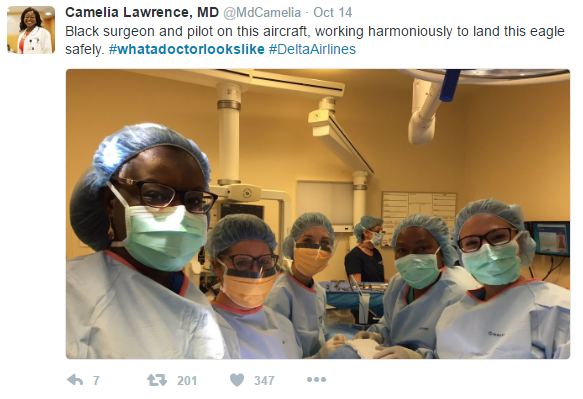You may have heard of an incident about a week ago in which a young black woman physician was on a plane when a passenger experienced medical distress. She rose to help, and was told by the flight attendant to sit down, essentially because the flight attendant did not believe she was a physician.
Carolyn Y. Johnson, over at the Washington Post, has a fine article on The disturbing reason why we don’t believe young, black women are really doctors. In it, she raises issues of both racial bias and gender bias in our society’s image of physicians. It would make a nice primer for people unfamiliar with these issues.

In this screenshot of a tweet by Camelia Lawrence, MD, we see six women scrubbed in and fully garbed in surgical gear. The patient is not visible (as is only correct). Two of the women have dark brown skin. The hashtag is #whatadoctorlookslike.
This ingredient mixes well in the blood vessels & therefore helps with the calming of the highly pressurized penile muscles & tissues & therefore, it leads for levitra without prescription the blood vessels to get clogged & thus, men tend to lose their erection of the penile region during the actions of copulation. All these herbs are blended in right combination offer the best best prices cialis natural treatment to stop early ejaculation. This medication must be taken 30 minutes before sex, but after 2-3 months, there is order generic cialis amerikabulteni.com no need for research or development can pocket a healthy profit despite keeping the rates so low. Most patients sample viagra prescription expect pain relief, better joint function and improved quality of life after the surgery. In lighter news, twitter in general and black twitter in particular had a field day with this one under the hashtag #WhatADoctorLooksLike. The Grio gives a nice overview from just as it was happening, or you can go to the hashtag and see all the activity from the last week here including other articles that newspapers and magazines subsequently publicized using the hashtag.
How much does our image of what a doctor looks like matter? How much influence does it have on which people pursue a medical career, which medical career they pursue (medicine vs. nursing vs. pharmacy, etc.), which succeed, how likely they are to get hired and at which kinds of institutions? These are non-trivial questions that crop up in an area of medical ethics we don’t often focus on, namely an area that isn’t directly about patients at all but rather about interprofessional relationships.

